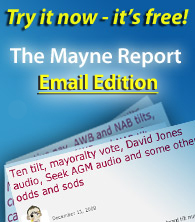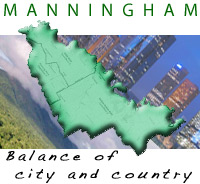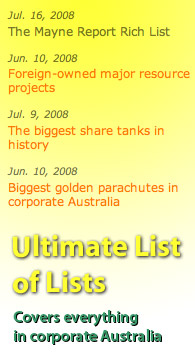Botch-ups, BHP and Rio, resource projects, Babcock
July 22, 2008
Here are Stephen Mayne's four stories from the Crikey edition on Thursday, 25 May, 2006.
5. A catalogue of botch-ups at Australia's biggest tollroad
By Stephen Mayne
News Ltd's Terry McCrann launched an extraordinary attack on the Bracks Government this week over its latest deal with tollroad company Transurban. It began as follows:
Citylink has become the money-making machine that is eating Melbourne. The Government's latest deal to pour what will become hundreds of millions of dollars of your money into Citylink's owner Transurban and on to its shareholders is a disgrace. It ranks up there with the very worst of the incompetent policies and deals of this Labor Government's predecessor, John Cain and Joan Kirner's 'Guilty Party'. Hell, rescind that. It's worse and dumber than any of the 'Guilty Party' stuff-ups.Strong stuff indeed, although I still reckon the stupidest Cain-Kirner decision was to give Tattersalls a $2 billion pokies licence for free – but that's another story. McCrann provides a convincing argument, which Treasurer John Brumby failed to address properly in a reply on McCrann's page today, and it can be summarised as follows:
The government wants an additional $903 million spent upgrading the interlinking West Gate freeway and Citylink tollroad to ease traffic congestion. Under the deal, Transurban will only have to spend $166 million and can recover all of this, plus interest, before the government gets a cent from the revenue uplift the extra lanes will deliver.All of this is a classic case of taxpayers being screwed in the long term for the simple goal of being able to claim the state's finances are in great shape in an election year, a point Ken Davidson also made in The Age today.
However, it's an election year and Victorian state debt is on the rise again so the Bracks Labor Government, still haunted by the fiscal incompetence of the Cain-Kirner years, wants to be seen to be fixing Melbourne's increasing traffic problems while not blowing the budget.
The solution is simple: surrender $2.9 billion that Transurban is due to hand over in tax-effective lease payments over the next 26 years in exchange for a paltry $609 million over the next four years which will fund the state's share of the construction costs. Now we all know about the time value of money but a hefty discount of 9.7% is being used to calculate this deal when the government could have borrowed the funds at just 5.5%.
Truth be known, Citylink has been an unmitigated disaster for Victorian motorists and taxpayers. Jeff Kennett's original contract was poorly scoped because less than ten years on we've already seen the Exhibition Street extension, Essendon Airport bypass and now the latest $903 million "amendment". Why couldn't all this have been foreseen at the time?
Despite construction cost blowouts that damaged Baulderstone Hornibrook and almost sent Transfield to the wall, combined with traffic revenue that still hasn't met prospectus forecasts, Transurban's investors are almost 1000% in front and that's after the likes of Macquarie Bank gorged themselves on outrageously large fees.
Imagine how much better off we'd all be today if Jeff Kennett had come out and said he was spending $1.5 billion solving most of Melbourne's traffic problems with this visionary road system that would carry a state-run toll for a few years. Rather than funnelling $200 million a year into Transurban's pockets for another 26 years and getting screwed with every renegotiation, the $1.5 billion construction cost would have been completed recovered by the toll revenue by about 2010, after which it could have become a freeway.
Sin City residents should stop whingeing about the Cross City Tunnel because Melbourne motorists spend almost as much with Transurban each year as Sydneysiders do on all of their tollroads combined. And the numbers are about to get a whole lot larger after taxpayers shell out $737 million to boost traffic at what is already one of the world's biggest and most lucrative tollroads.
21. Why BHP and Rio should ditch their London listings
By Stephen Mayne
AMP CEO Andrew Mohl made the following extraordinary claim at last week's AGM:
Australia is now the fourth largest private pension savings market in the world, underpinned by our mandatory superannuation savings regime. It is worth over $800 billion – and it is projected to triple between 2005 and 2015. By 2015, the Australian private sector pension market is expected to be the biggest in Asia – and indeed bigger than the markets of all other Asian countries combined, including Japan, India and China.So, little old Australia will have $2.4 trillion in super by 2015 and this will outstrip the three billion citizens of Asia. Clearly, this flood of capital poses a question of where all the money will go.
It is a question that our two remaining dual listed companies, BHP Billiton and Rio Tinto, should consider because their Australian shares trade at a premium to the London versions. Peter Costello's superannuation revolution will exacerbate this flood of capital, such that both companies could easily move to a 100% weighting in the Australian indices without causing too much indigestion for local funds.
There's something quite offensive about Rio Tinto having $30-40 billion worth of assets in Australia while being run out of London. For goodness sake, it should be mandatory that anyone reaping more than $5 billion a year Down Under should at the very least endeavour to base itself here.
So, how should these DLCs be unwound? The most obvious method would be simply to surrender their spots in the FTSE 100 and move to a secondary London listing. The ASX would immediately increase their weighting and there would be huge sales of stock by UK institutions to Australian institutions, including the Future Fund which will soon have $30 billion in cash burning a hole in its pocket.
At least this would end the publication of completely inaccurate figures in the weekend newspapers claiming that BHP Billiton is only worth $96 billion and Rio Tinto $34 billion. This happens because the papers take their feed from the ASX which excludes the London-listed shares. Rio Tinto has $76 billion worth of shares on the UK market and BHP Billiton has $70 billion worth so the two companies are actually capitalised at $110 billion and $166 billion respectively, which really is just too big for a relatively small market like Australia.
Given the extraordinary boom in Australian resources stocks, maybe both outfits should contemplate a demerger of their iron ore or coal operations. Each spin-off could be loaded up with debt, giving them literally tens of billions of dollar to fund buybacks of the UK shares as part of an Australianisation program.
As one of the great mining provinces of the world, our stock market is lopsided with two giants and then nothing else worth more than $10 billion, excluding Woodside Petroleum at $30 billion. It's time the two big gorillas redoubled their focus and commitment to Australia while breaking themselves up because the sum of the parts would almost certainly be worth more than the whole.
23. Who owns Australia's biggest resource projects?
By Stephen Mayne, hypocrite
Being a media tart, it is possible to sometimes adopt contradictory positions and yesterday was a classic example of hypocrisy. At 7.10pm eastern I was passionately railing against foreign domination of Australia's greatest resource projects during a lively discussion with ABC Perth Drive presenter Russell Woolf.
In fact one caller rang in to say, "if this bloke cares so much about Australia why is it is Crikey.com?" Having given up on lecturing the media about getting our domain name right, you can only laugh.
Fast forward four hours and the last story on Lateline last night concerned the controversy over the Snowy Hydro float and yours truly was interviewed slamming Senator Bill Heffernan for being "pathetically xenophobic" for worrying about a foreign investor one day seizing control.
It is partly defendable because my argument is that foreign investment should be welcome but corporate Australia has simply failed to land the bid assets and build global companies over the years. Don't be me started on BHP passing up a chance to buy 45% of Santos for $30 million in the last 1970s and selling 40% of Woodside at $3 a share in the early 1990s.
Now, here are the ownership and operational details of another four major Australian resource projects to keep our list coming along:
Gorgon: the giant LNG project off WA and gas processing plant at Barrow Island is now expected to cost as much as $18 billion with deliveries to begin in 2011. Operator Chevron has 50% with Shell and ExxonMobil each owning 25%. Heads of agreement have been signed with three customers for 25 years - Tokyo Gas, Chuaka Gas -bu Electric and Os with each taking 1.5 million tpy. The project is expected to generate $3 billion a year in export income and the Federal government will pocket an estimated $15 billion in resource rent tax over 25 years. The WA taxpayer gets nothing, but they are pressing the Federal government for a slice of the action. Zero Australian ownership but with huge construction blowouts that might not be such a bad thing.
Bass Strait: The Esso/BHP joint venture remains our biggest resource project in history having paid an incredible $68 billion in nominal taxes and at one point contributing 12% of Federal revenues. It's been in decline since 1986 when it peaked at 550,000 barrels a day and it's now down to about 100,000 barrels a day and falling at the rate of 15% a year. However, the 3.5 billion barrels produced so far are worth more than $300 billion in today's terms and there's still an estimated 15-25 years of life in the project thanks to plentiful gas reserves. With BHP 40% Australian owned, the overall local equity is just 20%, but the Federal Government is now raking in about $500 million a year in resource rent tax thanks to surging oil prices.
Ernest Henry: all the production figures at the Xstrata-owned copper-gold mine near Mt Isa are on page 41 of the 2005 results presentation. With 167,224 ounces of gold and 129,011 tonnes of copper concentrate, the $350 million mine should generate about $250 million in 2006. With annual profits of almost $100 million now flowing, the mine is presumably worth more than $1 billion after almost 10 years of production. Australian ownership is zero and the gold and copper royalty of 2.7% suggests Queensland taxpayers are collecting about $6 million a year.
Blair Athol: one of Australia's largest export thermal coal mines in Queensland's rich Bowen Basin which produces 9% of all coal used in Japanese power generation. Operated by Rio Tinto which owns 71.2%, Unisuper has 15%, Japan Coal Development Australia 10.4% and 3.4% is with J-Power, which operates 67 power stations in Japan. It produces 11 million tonnes a year which is worth about $800 million. The standard 7% Queensland coal royalty generates about $50 million and it is roughly 35% Australian owned.
Keep the tips coming to smayne@crikey.com.au and please note yesterday's claim there is no gold royalty in WA was wrong. Miners pay 2.5% after the first 2500 ounces provided the gold price is above $450 an ounce.
24. What to ask Babcock & Brown tomorrow?
By Stephen Mayne, small shareholder in four Babcock & Brown vehicles
The call came through from Babcock & Brown this morning politely inquiring whether there were any questions coming at tomorrow's AGM in Sydney that could be telegraphed in advance to allow answers to be prepared. Nice try!
AGMs should be full of lively unscripted debate. Sadly, institutions do all their talking in private with company executives and the Australian Shareholders Association often gets neutralised through an exchange of letters before an AGM.
Journalists don't send through copies of questions before press conferences and barristers don't telegraph their punches ahead of a cross-examination so why should shareholders make it easy for a board on their one public outing of the year?
The other point is that you often don't work out what questions to ask until the meeting is under way and the presentations and debates flow. If anyone's got suggested questions for Babcock tomorrow, drop a line to smayne@crikey.com.au.
It should be a lively debate, so those at a loose end in Sydney are welcome to get down to the Four Seasons in George Street from 10.30am. Visitors can observe but not speak, there's usually a good spread afterwards and it won't last for more than two hours.
Babcock is facing the same problem as Macquarie Bank with underperformance in some of its satellite funds, partly due to the excessive fees that are being ripped out and partly thanks to the excessive prices being paid for some assets.
I bought 340 Babcock & Brown Infrastructure (BBI) shares at $1.49 a pop this morning – a right bargain considering it hit a 13-month low this week, triggering Babcock CEO Phil Green and infrastructure boss Peter Hofbauer to each shell out $4.82 million over the past few days soaking up stock at $1.51. The announcement came out yesterday and instantly sent BBI up 4c to $1.50 this morning as investors follow the money.
BBI is a classic case of the flawed and conflicted Babcock and Macquarie model. After cleaning up the Beattie government with its original $630 million purchase of the Dalrymple Bay coal terminal in 2001, the asset was profitably flipped into a listed vehicle in 2002. Since then, BBI has been on a spending spree which has included $1.8 billion on New Zealand energy company Powerco, $1.5 billion on TD Ports in the UK and $280 million for an underground power cable business in New York State.
Fees have been ripped out every which way and now the stock is starting to slide, such that investors who stumped up $673 million at $1.58 a pop in a March capital raising, found themselves 8% underwater before the Rich Listers started propping up the stock in recent days.
All of this should make for some lively debate tomorrow as, just like Macquarie Bank, Babcock is an extremely issues-rich operation. The challenge is just comprehending the scale of what goes on, so send those suggested questions through.
Copyright © 2024 The Mayne Report. All rights reserved






















